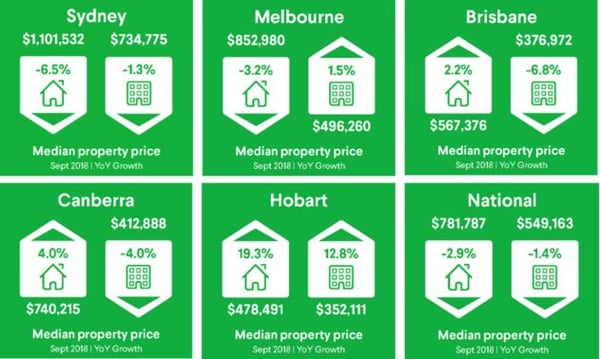Domain has released its latest quarterly house price report.
The report reveals national house prices are down over the quarter and year, with Sydney recording the largest annual fall in house prices.
Key data findings:
Houses
- Sydney house prices are now at late-2016 levels.
- Melbourne house prices are now at 2017 levels.
- Canberra house prices increased over the year but were flat over the quarter.
- Brisbane and Adelaide were also up over the year, but down slightly over the quarter.
- Hobart continued to grow strongly, recording double-digit annual growth.
- National house prices are down over the quarter and year.
Units
- Units in Sydney and Melbourne continued to outperform houses, while in all other capital cities houses outperformed units.
- Unit prices fell over the September quarter and year across all capital cities, apart from a minor quarterly improvement in Adelaide, and annual growth in Melbourne and Hobart.
- All capital cities are now underperforming relative to last year, except for Perth and Darwin.
- National unit prices continued to weaken, with annual growth declining for two consecutive quarters.
National
- House prices fell 2.6 per cent over the September quarter and 2.9 per cent over the year to $781,787.
- Unit prices fell 1.6 per cent over the September quarter and 1.4 per cent over the year to $549,163.
“It’s a development that will no doubt be welcomed by Australia’s first-home buyers - property prices across almost all capitals continue to fall. In many markets throughout Australia, gaining entry has become a greater possibility.
“The downturn has been aided by the tightening of credit by the banks following regulatory intervention and a bruising royal commission. Rising mortgage rates, tighter credit conditions and reduced borrowing power have impacted all capital cities to a varied degree.
“Moves by banks and their regulators to curb investor lending, combined with a drop in overseas buyers, has seen capital city house prices decrease 2.9 per cent over the year to $781,787. Units have proved more resilient, falling 1.4 per cent over the year to $549,163. Over the quarter, houses in Hobart and units in Adelaide have been the only segments to buck the national downward trend.
“Australia’s six-year low unemployment rate, strong population growth and continued economic growth suggests the decline we’re seeing, particularly in Sydney and Melbourne, has been driven by deliberate efforts to tighten credit availability. This is new territory for an Australian housing downturn, with prior slowdowns tending to coincide with increasing rates from the Reserve Bank.
“There are opportunities for buyers in all property cycles — the key is to be ready when opportunities arise.” said Domain Senior Research Analyst, Dr Nicola Powell.

Sydney
- House prices fell 3.1 per cent over the September quarter and 6.5 per cent over the year to $1,101,532.
- Unit prices fell 0.7 per cent over the September quarter and 1.3 per cent over the year to $734,775.
“Sydney recorded the largest annual fall in house prices of the capitals, declining 6.5 per cent. While this is the steepest annual fall in more than 20 years, it follows one of the largest price upswings on record. Prices during the boom surged 89.1 per cent in the space of almost six years and since the peak in mid-2017, prices have come back 8.1 per cent.
“Faced with tighter credit conditions and far fewer opportunities for capital gains, investors have retreated from the market, dampening competition and creating a potential window for first-home buyers.
“Sydney buyers and sellers are now operating in a housing market with prices at late-2016 levels.
“Units have proved more resilient to houses, with prices falling by a more marginal 1.3 per cent over the year, making them in line with the median unit price at the end of 2016. With Sydney unit prices gaining 68 per cent in five and a half years, the fall from the peak has been 4.4 per cent.
“With the fear of missing out gone, affordability marginally improved and competition between vendors gathering pace, buyers can reap the benefits of negotiating for a sale - a luxury they have not had for a number of years,” said Domain Senior Research Analyst, Dr Nicola Powell.
Melbourne
- House prices fell 3.9 per cent over the September quarter and 3.2 per cent over the year to $852,980.
- Unit prices fell 1.6 per cent over the September quarter and grew 1.5 per cent over the year to $496,260.
“Melbourne house prices have fallen the fastest of all capital cities over the quarter, down by 3.9 per cent to $852,980, resulting in the first annual decline in six years. The falls follow one of the longest runs of consecutive quarterly growth in recent history when house prices rose 72.9 per cent in just over 5 years.
“Houses at the middle to upper price points are feeling the brunt of the downturn, while an influx of first-home buyer activity has created sustained competition at the lower end. Buyers looking to upgrade may find themselves in a sweet spot given the prices between the lower end and middle market have narrowed.
“Units in Sydney and Melbourne continued to outperform houses, while the trend is reversed in all other capital cities. A more modest 1.6 per cent was shaved off the median unit price over the quarter in Melbourne, however, prices are still up over the year by 1.5 per cent. With a median unit price of $496,260, the stronger performance has been driven by affordability constraints and a cohort of first-home buyer activity.
“Despite the quarterly fall, Melbourne is holding firmer than Sydney. House prices have fallen 6.2 per cent from the peak and units 2.1 per cent - a modest decline compared to Sydney. Melbourne has always been a more owner-occupier led market, and therefore less exposed to retreating investor activity,” said Domain Senior Research Analyst, Dr Nicola Powell.
Brisbane
- House prices fell 0.4 per cent over the September quarter and grew 2.2 per cent over the year to $567,376.
- Unit prices fell 3.8 per cent over the September quarter and 6.8 per cent over the year to $376,972.
“Greater Brisbane house prices continued to rise on an annual basis, but the pace has slowed to half the growth recorded over the same period in 2017. While house prices have risen annually since the end of 2012, Brisbane largely missed the massive price surge that swept the east coast in recent years. The sunshine state remains a magnet for buyers seeking an affordable city to relocate. Interstate migration has hit a decade high, helping to propel Brisbane to one of Australia’s fastest growing cities. This will support demand for housing.
“A heightened supply of inner-city apartment completions is likely to have contributed to the steep fall we’ve seen in Brisbane median unit prices. It is plausible that many off-the-plan sales have settlement valuations lower than the contract price, posing a settlement risk and possible discounts on resales,” said Domain Senior Research Analyst, Dr Nicola Powell.
Adelaide
- House prices fell 0.3 per cent over the September quarter and increased 3.8 per cent over the year to $535,527.
- Adelaide units were the only capital city to increase over the quarter by 1.3 per cent but marginally declined 0.2 per cent over the year to $316,163.
“Adelaide is proving an incredibly robust market, experiencing more than five years of annual growth. Despite this sustained period, the city largely missed the east coast price surge and remains one of the more affordable capital cities. Adelaide and Hobart were the only capital cities to record a higher pace of annual growth compared to the same period last year.
“Despite tighter lending standards impacting the broader Australian housing market, mortgage rates remain low compared to historic standards. This, combined with Adelaide’s relative affordability, will underpin further demand for housing,” said Domain Senior Research Analyst, Dr Nicola Powell.
Canberra
- House prices remained steady over the September quarter and increased 4.0 per cent over the year to $740,215.
- Unit prices fell 3.4 per cent over the September quarter and 4.0 per cent over the year to $412,888.
“Canberra homeowners have reaped the benefit of six consecutive years of house price growth, with September proving no different. House prices in the nation’s capital bucked the falling trend of national prices and continued to grow over the year, though the pace of growth has eased to less than half of what was recorded last year.
“New residents continue to be lured to the capital, which offers greater affordability, growing job prospects, a higher average wage than neighbouring state capitals and the quarter acre block an attainable reality - not just a dream. This will continue to support demand for housing and price rises, although the pace of growth will remain subdued as borrowers face a more restrictive lending environment,” said Domain Senior Research Analyst, Dr Nicola Powell.
Perth
- House prices fell 2.4 per cent over the September quarter and 2.2 per cent over the year to $544,609.
- Unit prices fell 7.1 per cent over the September quarter and 4.5 per cent over the year to $347,089.
“Perth’s housing market continued to show early signs of improved conditions, although this is concentrated at the upper-end for both houses and units. It has been three and a half years since the broader housing market in Perth has seen positive growth. It is still likely to take some time yet for Perth to recover, as buyers adjust to the conservative and somewhat restrictive lending behaviour from banks. Housing finance activity has stabilised over the past few months and population growth has begun to show some signs of a positive turnaround,” said Domain Senior Research Analyst, Dr Nicola Powell.
Hobart
- House prices increased 3.7 per cent over the September quarter and 19.3 per cent over the year to $478,491. The only capital city to record double-digit house price growth.
- Unit prices fell 4.1 per cent over the September quarter, however increased 12.8 per cent over the year to $352,111.
“Hobart remains the strongest Australian capital city market with continued double-digit annual growth.
“Despite this, Hobart is still Australia’s most affordable city, although the house price gap between Adelaide and the Tasmanian capital has narrowed to a 12-year low. Overseas migration has now fallen from historic highs, but buyers remain active and with limited supply to choose from, we’ll likely see upward pressure on prices at least in the short- to medium-term,” said Domain Senior Research Analyst, Dr Nicola Powell.
Darwin
- House prices fell 2.2 per cent over the September quarter and 12 per cent over the year to reach $519,260.
- Unit prices fell 2.6 per cent over the September quarter and 11.4 per cent over the year to reach $312,456.
“Darwin unit prices continue to fall, however, the rate of decline is less than half of what was recorded over the same period last year. Annual house price falls continue to gather momentum, in line with most other capital cities.
“Darwin is a key focus for the Northern Territory Government, with plans to rejuvenate the city and policies in place to attract key workers to relocate. The lack of population growth has been a major drag on housing demand, housing finance activity and building starts, which has impacted the overall economic outlook for the city. Darwin’s economy remains fragile as unemployment rises and population growth stagnates. However, the long-term approach to addressing population growth will support future demand for housing,” said Domain Senior Research Analyst, Dr Nicola Powell.png)






.png?width=229&height=115&name=RE%20Investar-Logo-MRI_Colour%20web%20229x115px%20(1).png)